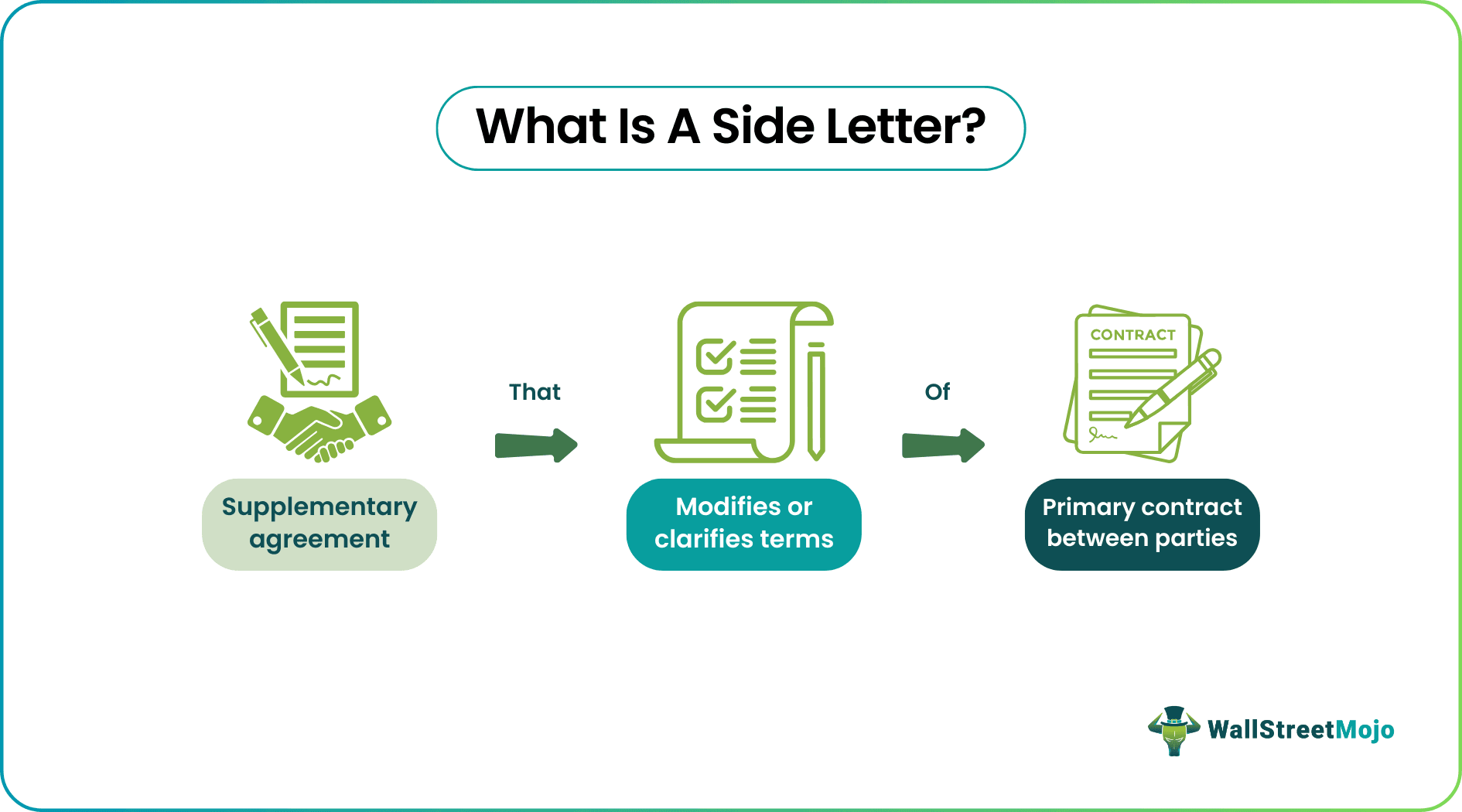Table Of Contents
What Is A Side Letter?
A Side Letter is a supplement to the main legal contract. It is used in corporate, finance, and commercial deals. When a main official agreement is drafted, a side letter is attached to clarify, mention, or support a complex expression of some clauses of the main contract.

Its utility may vary depending on the agreement or the nature of the deal between the interested parties. When the main contracts are ambiguous and do not offer a detailed explanation, side letters are exercised to avoid future errors or misunderstandings.
Key Takeaways
- Side letters are supplementary documents stating rules and regulations not covered in the main contract of business, operations, finance, or exchange.
- It can be a term sheet, appointment letter, investment agreement, or a simple letter of intent.
- Such letters are treated equally and executed as a contract deed under the principal contract.
- These letters fall under the Contract Acts and are used by fund managers and investors to gauge the credibility of investment arrangements.
Side Letter Agreement Explained
A side letter is an extra associated document requested or produced for clarity and transparency of agreement. Typically, a general agreement does not mention critical clauses and terms that may need to be clarified in the future. There is a provision for this document, and they are offered the same stature as the main contract and are legally binding and enforceable.
It can be used in any form of contract or legal agreement but is primarily used between funds and investors to ensure that the latter is knowledgeable of all the terms and conditions of the investment procedure. In some cases, an investor needs to initiate the transaction. It allows investors to strike a more favorable deal with the fund managers. This document in private equity is primarily used in formation funding, generally a day or two to make last-minute requests. Limited partners utilize it to accommodate closings without the partnership agreement.
The parties involved can produce or request this document for multiple reasons rather than just for clarification. Therefore, such letters are dynamic and prove beneficial to participants to enter into a deal with minute details and obligations. Many contracts are available in the public domain. Therefore, confidential and private information is mentioned in the document.
Main contracts frequently overlook crucial clauses and terms that may require clarification later on. These supplementary documents, held in equal regard to the primary contract, play a crucial role in ensuring that all parties fully comprehend the intricacies of their arrangements. While commonly utilized in various contractual settings, they are particularly prevalent in transactions involving funds and investors, facilitating informed decision-making and allowing for more favorable negotiations between parties. Whether utilized to initiate transactions or accommodate last-minute requests, these documents serve as indispensable tools in navigating complex agreements, covering aspects such as rights transfer, redemption, notices, and fee restrictions.
Examples
Let us understand the concept with the help of some hypothetical and real-world scenarios.
Example #1
Suppose Denver owns an apartment that he is looking to give on rent. Chloe, who is new in town, contacts Denver, and they both agree to establish a rent agreement. The contract is for nine months, but Denver is particular about his place. Though the contract states the standard clauses and guidelines, Denver produces a side letter that comprises some additional rules that Chloe must follow and maintain until she lives in Denver's apartment. This document is offered with the main contract, and after reading it, Chloe obliges to each term and condition and signs the document.
Example #2
In 2021, the US Securities and Exchange Commission (SEC) chair proposed that the agency will consider new rules and regulations on how private funds will charge the investors and gauge their performance. He pressed on the subject, mentioning side letters as a workaround to look after the fund constitutions. The secretary agreed to have asked staff for improvement suggestions for hedge fund reporting and disclosure. With multiple associated fees like performance and management fees, there is a transparency issue that most concerns him.
Template
Benefits
The benefits of side letters are -
- With this document, any contract has two separate documents to track compliance.
- It is helpful to encourage transparency and make clear and direct obligations that become ambiguous in general contract agreements.
- It ensures that parties know all the terms and conditions, considering even the tiniest details.
- A borrowing party can ask for this document to ensure that there is nothing left to discuss. This, in turn, prevents incidents of future misunderstandings.
- It decreases or prevents parties from falling into the trap of general misunderstanding and potential fraud and acts as legal proof.
- It is a cheap instrument that is legally binding.
- In deals that involve a large sum of money and promises, it is better to have a side letter requested.


